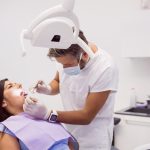Image Guided Surgery
Image Guided Surgery
Image guided Surgery with CBCT combines the expertise and experience of Dr. Arroyo with state-of-the-art medical imaging and surgical planning technology, a combination that offers a number of distinct advantages over traditional surgeries. Among these is the capacity for more detailed diagnosis and greater precision in surgical planning, which leads to less invasive procedures and more reliable surgical results. More precise and less invasive surgeries mean less discomfort and chair time for patients, as well as shorter recovery times and reduced risk of complications during and after surgery.
CBCT stands for Cone Beam Computed Tomography, which is the most advanced form of dental imaging available today. An updated version of the CT scanning technology used in hospitals,but with about 10 times less radiation exposure for patients, this state-of-the-art imaging technology gathers digital data and precise anatomical information to produce high-definition,
three-dimensional images of all oral and maxillofacial structures.This gives Dr. Arroyo the ability to gather more precise information and measurements and to visualize internal anatomy in much greater detail than is possible with 2-D imaging, clearly seeing the position and orientation of critical structures, such as nerves, tooth roots, sinuses and airways for more precise diagnosis and treatment planning.
In image guided surgery, which is the primary method used by Dr. Arroyo in the placement of dental implants, information gathered via CBCT 3-D imaging is transformed by specialized computer software into a very accurate and interactive 3-D virtual model of a patient’s oral structure and anatomy. That virtual model is than used by the oral surgeon and restorative
dentist to plan the surgical procedure in precise detail, allowing them to simulate different treatment methods and predict their outcomes accurately in order to establish an optimal surgical treatment plan. Then, that detailed plan is used to create a surgical guide, or template, to be used during the procedure, guiding the surgeon throughout to ensure optimal implant positioning, depth and angulation.
Image guided surgery with CBCT technology holds a number of important advantages over traditional surgeries. The accuracy and detail of 3-D imaging takes the guesswork out of diagnosis and surgical planning, leading to more precise placement of implants
that results in more reliable functional and aesthetic outcomes. Since surgeons have a clear view of oral structure during surgical planning, risk of complications, such as damage to nerves or adjacent tooth roots, is greatly reduced, and surgeries are faster and less invasive, done with much smaller incisions than traditional implant placement or, in some cases, no incisions at all. The bottom line is this: Image guided surgery with CBCT offers patients a safer, quicker and more comfortable surgical experience, shorter recovery times and a more functional and attractive new smile.









